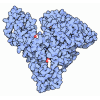[English] 日本語
 Yorodumi
Yorodumi- PDB-1xls: Crystal structure of the mouse CAR/RXR LBD heterodimer bound to T... -
+ Open data
Open data
- Basic information
Basic information
| Entry | Database: PDB / ID: 1xls | ||||||
|---|---|---|---|---|---|---|---|
| Title | Crystal structure of the mouse CAR/RXR LBD heterodimer bound to TCPOBOP and 9cRA and a TIF2 peptide containg the third LXXLL motifs | ||||||
 Components Components |
| ||||||
 Keywords Keywords | TRANSCRIPTION / LBD / nuclear receptor / CAR / xenobiotic | ||||||
| Function / homology |  Function and homology information Function and homology informationHATs acetylate histones / MLL4 and MLL3 complexes regulate expression of PPARG target genes in adipogenesis and hepatic steatosis / Synthesis of bile acids and bile salts via 27-hydroxycholesterol / Endogenous sterols / Synthesis of bile acids and bile salts / Synthesis of bile acids and bile salts via 7alpha-hydroxycholesterol / Recycling of bile acids and salts / Regulation of lipid metabolism by PPARalpha / Activated PKN1 stimulates transcription of AR (androgen receptor) regulated genes KLK2 and KLK3 / Nuclear Receptor transcription pathway ...HATs acetylate histones / MLL4 and MLL3 complexes regulate expression of PPARG target genes in adipogenesis and hepatic steatosis / Synthesis of bile acids and bile salts via 27-hydroxycholesterol / Endogenous sterols / Synthesis of bile acids and bile salts / Synthesis of bile acids and bile salts via 7alpha-hydroxycholesterol / Recycling of bile acids and salts / Regulation of lipid metabolism by PPARalpha / Activated PKN1 stimulates transcription of AR (androgen receptor) regulated genes KLK2 and KLK3 / Nuclear Receptor transcription pathway / Cytoprotection by HMOX1 / positive regulation of nuclear receptor-mediated glucocorticoid signaling pathway / retinoic acid-responsive element binding / NR1H2 & NR1H3 regulate gene expression linked to triglyceride lipolysis in adipose / NR1H2 & NR1H3 regulate gene expression linked to gluconeogenesis / NR1H2 & NR1H3 regulate gene expression to limit cholesterol uptake / nuclear glucocorticoid receptor binding / positive regulation of thyroid hormone receptor signaling pathway / NR1H2 & NR1H3 regulate gene expression linked to lipogenesis / nuclear retinoic acid receptor binding / Carnitine shuttle / retinoic acid binding / positive regulation of female receptivity / TGFBR3 expression / positive regulation of vitamin D receptor signaling pathway / nuclear vitamin D receptor binding / nuclear thyroid hormone receptor binding / Signaling by Retinoic Acid / DNA binding domain binding / RNA polymerase II intronic transcription regulatory region sequence-specific DNA binding / NR1H2 & NR1H3 regulate gene expression to control bile acid homeostasis / LBD domain binding / locomotor rhythm / aryl hydrocarbon receptor binding / nuclear steroid receptor activity / cellular response to Thyroglobulin triiodothyronine / regulation of lipid metabolic process / regulation of glucose metabolic process / Synthesis of bile acids and bile salts / positive regulation of cholesterol efflux / Synthesis of bile acids and bile salts via 27-hydroxycholesterol / Endogenous sterols / Synthesis of bile acids and bile salts via 7alpha-hydroxycholesterol / response to retinoic acid / positive regulation of bone mineralization / nuclear retinoid X receptor binding / Transcriptional regulation of brown and beige adipocyte differentiation by EBF2 / retinoic acid receptor signaling pathway / cellular response to hormone stimulus / Recycling of bile acids and salts / transcription regulator inhibitor activity / NR1H3 & NR1H2 regulate gene expression linked to cholesterol transport and efflux / hormone-mediated signaling pathway / DNA polymerase binding / : / Regulation of lipid metabolism by PPARalpha / peroxisome proliferator activated receptor signaling pathway / peptide binding / BMAL1:CLOCK,NPAS2 activates circadian expression / Activation of gene expression by SREBF (SREBP) / response to progesterone / cerebellum development / nuclear estrogen receptor binding / nuclear receptor binding / transcription coregulator binding / negative regulation of smoothened signaling pathway / RNA polymerase II transcription regulatory region sequence-specific DNA binding / SUMOylation of intracellular receptors / mRNA transcription by RNA polymerase II / circadian regulation of gene expression / Heme signaling / PPARA activates gene expression / Transcriptional activation of mitochondrial biogenesis / Cytoprotection by HMOX1 / circadian rhythm / Transcriptional regulation of white adipocyte differentiation / Nuclear Receptor transcription pathway / RNA polymerase II transcription regulator complex / Activation of anterior HOX genes in hindbrain development during early embryogenesis / male gonad development / nuclear receptor activity / Transcriptional regulation of granulopoiesis / : / sequence-specific double-stranded DNA binding / osteoblast differentiation / response to estradiol / nervous system development / regulation of gene expression / MLL4 and MLL3 complexes regulate expression of PPARG target genes in adipogenesis and hepatic steatosis / double-stranded DNA binding / DNA-binding transcription activator activity, RNA polymerase II-specific / transcription regulator complex / dendritic spine / sequence-specific DNA binding / RNA polymerase II-specific DNA-binding transcription factor binding / DNA-binding transcription factor activity, RNA polymerase II-specific / cell differentiation / cytoskeleton / transcription coactivator activity / receptor complex Similarity search - Function | ||||||
| Biological species |  Homo sapiens (human) Homo sapiens (human)  | ||||||
| Method |  X-RAY DIFFRACTION / X-RAY DIFFRACTION /  SYNCHROTRON / SYNCHROTRON /  MOLECULAR REPLACEMENT / Resolution: 2.96 Å MOLECULAR REPLACEMENT / Resolution: 2.96 Å | ||||||
 Authors Authors | Suino, K. / peng, L. / Reynolds, R. / Li, Y. / Cha, J.-Y. / Repa, J.J. / Kliewer, S.A. / Xu, H.E. | ||||||
 Citation Citation |  Journal: Mol.Cell / Year: 2004 Journal: Mol.Cell / Year: 2004Title: The nuclear xenobiotic receptor CAR: structural determinants of constitutive activation and heterodimerization. Authors: Suino, K. / Peng, L. / Reynolds, R. / Li, Y. / Cha, J.Y. / Repa, J.J. / Kliewer, S.A. / Xu, H.E. | ||||||
| History |
|
- Structure visualization
Structure visualization
| Structure viewer | Molecule:  Molmil Molmil Jmol/JSmol Jmol/JSmol |
|---|
- Downloads & links
Downloads & links
- Download
Download
| PDBx/mmCIF format |  1xls.cif.gz 1xls.cif.gz | 410 KB | Display |  PDBx/mmCIF format PDBx/mmCIF format |
|---|---|---|---|---|
| PDB format |  pdb1xls.ent.gz pdb1xls.ent.gz | 332.5 KB | Display |  PDB format PDB format |
| PDBx/mmJSON format |  1xls.json.gz 1xls.json.gz | Tree view |  PDBx/mmJSON format PDBx/mmJSON format | |
| Others |  Other downloads Other downloads |
-Validation report
| Summary document |  1xls_validation.pdf.gz 1xls_validation.pdf.gz | 2.4 MB | Display |  wwPDB validaton report wwPDB validaton report |
|---|---|---|---|---|
| Full document |  1xls_full_validation.pdf.gz 1xls_full_validation.pdf.gz | 2.6 MB | Display | |
| Data in XML |  1xls_validation.xml.gz 1xls_validation.xml.gz | 89.1 KB | Display | |
| Data in CIF |  1xls_validation.cif.gz 1xls_validation.cif.gz | 114 KB | Display | |
| Arichive directory |  https://data.pdbj.org/pub/pdb/validation_reports/xl/1xls https://data.pdbj.org/pub/pdb/validation_reports/xl/1xls ftp://data.pdbj.org/pub/pdb/validation_reports/xl/1xls ftp://data.pdbj.org/pub/pdb/validation_reports/xl/1xls | HTTPS FTP |
-Related structure data
| Similar structure data |
|---|
- Links
Links
- Assembly
Assembly
| Deposited unit | 
| ||||||||
|---|---|---|---|---|---|---|---|---|---|
| 1 | 
| ||||||||
| 2 | 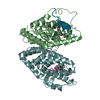
| ||||||||
| 3 | 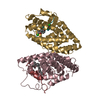
| ||||||||
| 4 | 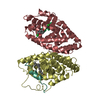
| ||||||||
| 5 | 
| ||||||||
| 6 | 
| ||||||||
| 7 | 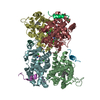
| ||||||||
| Unit cell |
|
- Components
Components
-Protein , 2 types, 8 molecules ABCDEFGH
| #1: Protein | Mass: 26011.125 Da / Num. of mol.: 4 / Fragment: CAR LBD / Mutation: residues 116-238 Source method: isolated from a genetically manipulated source Source: (gene. exp.)  Homo sapiens (human) / Gene: human / Plasmid: PETDUET / Species (production host): Escherichia coli / Production host: Homo sapiens (human) / Gene: human / Plasmid: PETDUET / Species (production host): Escherichia coli / Production host:  #2: Protein | Mass: 28004.400 Da / Num. of mol.: 4 / Fragment: RXRalpha LBD / Mutation: residues 225-462 Source method: isolated from a genetically manipulated source Source: (gene. exp.)   |
|---|
-Protein/peptide , 1 types, 8 molecules IJKLMNOP
| #3: Protein/peptide | Mass: 2125.381 Da / Num. of mol.: 8 / Fragment: TIF2 / Mutation: the third LXXLL motif / Source method: obtained synthetically / Source: (synth.)  |
|---|
-Non-polymers , 3 types, 96 molecules 
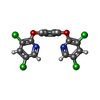



| #4: Chemical | ChemComp-9CR / ( #5: Chemical | ChemComp-TCD / #6: Water | ChemComp-HOH / | |
|---|
-Experimental details
-Experiment
| Experiment | Method:  X-RAY DIFFRACTION / Number of used crystals: 1 X-RAY DIFFRACTION / Number of used crystals: 1 |
|---|
- Sample preparation
Sample preparation
| Crystal | Density Matthews: 2.4 Å3/Da / Density % sol: 48 % |
|---|---|
| Crystal grow | Temperature: 295 K / Method: vapor diffusion, hanging drop / pH: 6.5 Details: 10% PEG2K, 3% 1,6 hexanediol, 0.1 M di-ammonium tartrate, pH 6.5, VAPOR DIFFUSION, HANGING DROP, temperature 295K |
-Data collection
| Diffraction | Mean temperature: 100 K |
|---|---|
| Diffraction source | Source:  SYNCHROTRON / Site: SYNCHROTRON / Site:  APS APS  / Beamline: 32-ID / Wavelength: 1 Å / Beamline: 32-ID / Wavelength: 1 Å |
| Detector | Type: MARRESEARCH / Detector: CCD / Date: Feb 17, 2004 / Details: diamond crystal |
| Radiation | Monochromator: diamond crystal / Protocol: SINGLE WAVELENGTH / Monochromatic (M) / Laue (L): M / Scattering type: x-ray |
| Radiation wavelength | Wavelength: 1 Å / Relative weight: 1 |
| Reflection | Resolution: 2.96→20 Å / Num. all: 45946 / Num. obs: 42821 / % possible obs: 93.2 % / Observed criterion σ(F): 0 / Observed criterion σ(I): 0 / Redundancy: 3.5 % / Biso Wilson estimate: 39 Å2 / Rmerge(I) obs: 0.171 / Rsym value: 0.121 / Net I/σ(I): 10.2 |
| Reflection shell | Resolution: 2.96→3.06 Å / Redundancy: 3.2 % / Rmerge(I) obs: 0.88 / Mean I/σ(I) obs: 1.9 / Num. unique all: 4227 / Rsym value: 0.76 / % possible all: 92.5 |
- Processing
Processing
| Software |
| |||||||||||||||||||||||||
|---|---|---|---|---|---|---|---|---|---|---|---|---|---|---|---|---|---|---|---|---|---|---|---|---|---|---|
| Refinement | Method to determine structure:  MOLECULAR REPLACEMENT / Resolution: 2.96→19.99 Å / Rfactor Rfree error: 0.005 / Data cutoff high absF: 1528881.54 / Data cutoff low absF: 0 / Isotropic thermal model: RESTRAINED / Cross valid method: THROUGHOUT / σ(F): 0 / Stereochemistry target values: Engh & Huber MOLECULAR REPLACEMENT / Resolution: 2.96→19.99 Å / Rfactor Rfree error: 0.005 / Data cutoff high absF: 1528881.54 / Data cutoff low absF: 0 / Isotropic thermal model: RESTRAINED / Cross valid method: THROUGHOUT / σ(F): 0 / Stereochemistry target values: Engh & Huber
| |||||||||||||||||||||||||
| Solvent computation | Solvent model: FLAT MODEL / Bsol: 23.5547 Å2 / ksol: 0.295007 e/Å3 | |||||||||||||||||||||||||
| Displacement parameters | Biso mean: 54 Å2
| |||||||||||||||||||||||||
| Refine analyze |
| |||||||||||||||||||||||||
| Refinement step | Cycle: LAST / Resolution: 2.96→19.99 Å
| |||||||||||||||||||||||||
| Refine LS restraints |
| |||||||||||||||||||||||||
| Refine LS restraints NCS | NCS model details: CONSTR | |||||||||||||||||||||||||
| LS refinement shell | Resolution: 2.96→3.13 Å / Rfactor Rfree error: 0.018 / Total num. of bins used: 6
| |||||||||||||||||||||||||
| Xplor file |
|
 Movie
Movie Controller
Controller


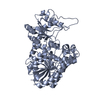
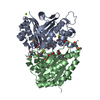
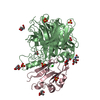
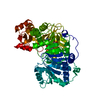
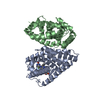
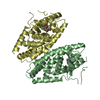
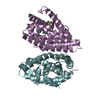


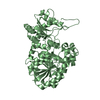
 PDBj
PDBj






